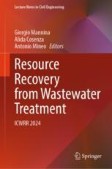Search
Search Results
-
Disinfection of corona and myriad viruses in water by non-thermal plasma: a review
Nowadays, in parallel to the appearance of the COVID-19 virus, the risk of viruses in water increases leading to the necessity of develo** novel...

-
A dual-functional sulfone biscompound containing 1,2,3-triazole moiety for decolorization and disinfection of contaminated water
Water decontamination from toxic dyes and pathogenic microorganisms is critical for life on Earth. Herein, we report the synthesis of sulfone...

-
Pyrite-based denitrification combined with electrochemical disinfection to remove nitrate and microbial contamination from groundwater
Nitrate and microbial contamination of groundwater can occur in countries that face intense urbanization and inadequate sanitation. When groundwater...

-
Pulsed ultraviolet (PUV) disinfection of artificially contaminated seawater seeded with high levels of pathogen disease indicators as an alternative for the shellfish industry depuration systems
The increase in pathogen levels in seawater threatens the safety of entire aquatic ecosystems. Foodborne pathogens can potentially accumulate in...

-
Using potassium ferrate control hazardous disinfection by-products during chlorination
The generation of hazardous disinfection by-product is one of the major problems in drinking water chlorination. This study aims to investigate the...

-
Mechanisms of Action of Emerging Contaminants: Disinfection Byproducts
Although disinfection byproducts (DBPs) can be detected in surface water, most of these emerging contaminants exist in the drinking water system,...
-
Temporal and Spatial Distribution of Disinfection Byproducts in Drinking Water Supplied to the Mega City of Vietnam and Assessment of the Associated Risks
This study investigated the characteristics (levels, profiles, seasonal variations) of disinfection by-products (DBPs) including four trihalomethanes...

-
Effects of pre-oxidation by ozone, permanganate and ferrate on generation and toxicities of disinfection byproducts
When organic compounds are pre-oxidized before coagulation, the disinfection byproducts are usually generated in the following chlorination process...

-
The influence of microclimate conditions on ozone disinfection efficacy in working places
In recent years, the sanitization of environments, devices, and objects has become mandatory to improve human and environmental safety, in addition...

-
Enhanced formation of trihalomethane disinfection byproducts from halobenzoquinones under combined UV/chlorine conditions
Halobenzoquinones (HBQs) are highly toxic disinfection byproducts (DBPs) and are also precursors of other DBPs such as trihalomethanes (THMs). The...

-
Disinfection in Water and Used Water Purification
Disinfection in water treatment has a long tradition. In the course of time, five processes/agents have established themselves in water technology....
-
Kinetics and Monte Carlo simulation of UV disinfection of B. subtilis spores and SARS-CoV-2 in dried saliva droplets
Surfaces can be contaminated by droplets produced through coughing or sneezing. In this exploratory work, the UV disinfection results of Bacillus...

-
Pseudoviruses for the assessment of coronavirus disinfection by ozone
The COVID-19 pandemic has severely impacted public health worldwide. Evidence of SARS-CoV-2 transmission via aerosols and surfaces has highlighted...

-
Synthesis and application of titanium dioxide photocatalysis for energy, decontamination and viral disinfection: a review
Global pollution is calling for advanced methods to remove contaminants from water and wastewater, such as TiO 2 -assisted photocatalysis. The...

-
Identification, Elucidation, and Toxicity Assessment of Nontarget Disinfection By-products from Fipronil Chlorination
In the present study, fipronil degradation was evaluated in typical chlorination conditions (fipronil: 20 μg L −1 ; free chlorine concentration: 2 mg L −1...

-
Evaluating Disinfection Techniques of Water Treatment Using Multi-criteria Decision-Making Method
Disinfection in the process of water treatment is used to make water safe for intended purpose by eliminating pathogenic microorganisms from it....
-
Effects of process factors on the performance of electrochemical disinfection for wastewater in a continuous-flow cell reactor
Although electrochemical disinfection has been shown to be an effective approach to inactivate bacteria in saline water, the effects of process...

-
Toxicity of disinfection byproducts formed during the chlorination of sulfamethoxazole, norfloxacin, and 17β-estradiol in the presence of bromide
Brominated disinfection byproducts (Br-DBPs) are formed during the disinfection process of water containing bromine ions, such as marine aquaculture...

-
Optimizing Wastewater Disinfection with Peracids and Chlorine: An Advanced Control Strategy Integrating Batch Kinetics and Hydrodynamics for Reliable Treatment Performance
Chlorine-based disinfectants are widely used in North America and can achieve the desired microbiological limits. However, these disinfectants are...
-
Smartphone-powered efficient water disinfection at the point of use
Clean water free of bacteria is a precious resource in areas where no centralized water facilities are available. Conventional chlorine disinfection...

